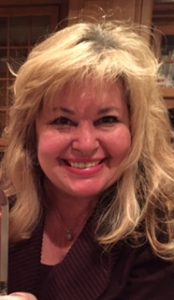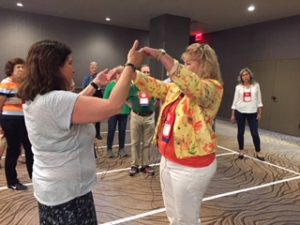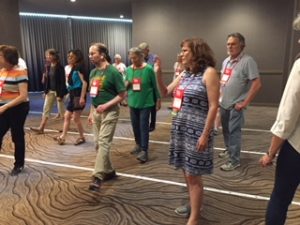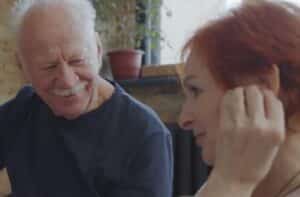By Lynn Rousseau and Debbie Mohney
Have you ever watched people on the dance floor having a great time and pictured yourself out there with them? And then you thought, “But wait, I’m not like them; they can hear the music…and I can’t.” We are here to tell you: You can dance with a hearing loss! It’s great fun and a wonderful way to be an active part of the social scene. Some of you will remember dancing back in the day, when you were able to rock to the beat with the best of them. Others may be complete newcomers to the experience of gliding around the room with a partner. And some may think that because you have issues with balance or mobility, you won’t be able to enjoy the freedom of dancing. It does take practice and persistence, but everyone can enjoy dance moves.

First, a little bit about ourselves and our history. Although we didn’t meet until we were adults, both of us started dance as little girls, Lynn in Florida and Debbie in Colorado.
Lynn was a quiet, well-behaved preschooler, but her parents were frustrated that she didn’t seem to pay attention and often didn’t respond to their requests. When they took her from her home in Miami to have her hearing tested at Johns Hopkins, the results showed a profound loss and she was fitted for her first pair of hearing aids at age 3. (They were the early, cumbersome style with a shoulder harness to support the battery pack and wires to each ear.)

Lynn was so amazed when she first heard her own footsteps that she would stomp around her house just to enjoy the sound! Soon after, out at dinner with her family, she experienced live music and professional dancers and she was smitten. Her mother found a wonderful, supportive dance teacher who accepted her fully. Although Lynn couldn’t hear much of the music, the teacher would tap out the beat with her cane to give a visual cue. From that beginning, Lynn developed her sense of rhythm and joined dance groups. Her professional career was in dance and modeling; she performed in many ensembles including a 3-year stint as a go-go dancer on local TV when she was just 15. Today she prefers jazz dance because of its easy-to-follow beat, and is looking for opportunities to enjoy ballroom dancing more often.
Debbie was born with a high frequency hearing loss but it wasn’t until she was 18 that she got a single analog hearing aid. She started dancing at a young age and enjoyed the feeling of moving to a beat. Like Lynn, she had an accepting, supportive dance teacher who encouraged her to enjoy the freedom of movement and gave her visual cues. A large part of developing her dance ability was practicing keeping time.
For many years, Debbie preferred “free-dancing” to live music. It wasn’t until the late 1990’s when hearing aid technology improved dramatically that she was able to really hear the music she danced to. She signed up for line dance classes after she got newer style aids and started partner dancing a few years later. Now she participates regularly in a dance class, often substituting for her instructor when the woman is out, and really enjoys performing in dance routines at senior centers, libraries and other local venues. And, of course, Debbie loves to go out dancing in her community, especially when there’s live music performed by her musical son and his swing band.
 Because we learned to dance when we were children and have been enjoying it for many years, we’ve gotten past that early stage where we were learning and building our confidence. But everyone must start somewhere, and if you’d like to enjoy a fun activity which will introduce you to new friends, get your body moving, and improve your balance and posture, here are some tips on how to get started:
Because we learned to dance when we were children and have been enjoying it for many years, we’ve gotten past that early stage where we were learning and building our confidence. But everyone must start somewhere, and if you’d like to enjoy a fun activity which will introduce you to new friends, get your body moving, and improve your balance and posture, here are some tips on how to get started:
Ask your friends where they go dancing. Look for places to take beginning lessons such as the local recreation center, senior center, university dance club or dance studio. Find out where local dances are held; there’s often a lesson before the dance begins. And to really immerse yourself, investigate intensive dance weekends.
Use your senses of sight and touch in addition to your hearing, and, if it helps, use a personal listening system to amplify the music. Choose a venue that allows you to see the instructors; many studios have mirrors to help you see them as well as the other dancers.
When you are at a dance, practice with different partners and take turns leading and following. Real time classes (when you are learning at a dance) or private lessons can help with technique. Keep in mind that everyone’s style is unique and you can try out different moves until you find the ones that feel right to you.
 Look online (at youtube.com) to find instructional “how-to” videos for almost any dance you’d like to learn. These are a good starting point; you can play them over and over again. Although they may not be captioned, you can stop and start as many times as you need to. (And if you want to know what the words to the songs are, use your computer or smartphone to find the lyrics.) Here are some styles of dances you may want to check out:
Look online (at youtube.com) to find instructional “how-to” videos for almost any dance you’d like to learn. These are a good starting point; you can play them over and over again. Although they may not be captioned, you can stop and start as many times as you need to. (And if you want to know what the words to the songs are, use your computer or smartphone to find the lyrics.) Here are some styles of dances you may want to check out:
- Get Moving: Body Groove-Super Funk, Hip Hop, Thriller
- Line Dances: Electric Slide, Rock Around the Clock, , Ladies’ Rhumba
- Party Dances: Cha Cha Shuffle, Cotton Eyed Joe, Cupid Shuffle
Remember, there’s no age limit—dancing is all about having fun!
Lynn Rousseau and Debbie Mohney have taught You Can Dance workshops at HLAA Conventions in Washington DC, Salt Lake City and Minneapolis.
Lynn Rousseau is the founder of HLAA-Gainesville Chapter, past State Chapter Coordinator and past President of HLAA Florida. She serves on disability advisory boards for the Airline Travel industry, Amtrak, Royal Caribbean Cruise Lines and her local county government. Lynn is a retired professional dancer.
Debbie Mohney serves as State Chapter Coordinator of HLAA Colorado and is a member of HLAA-Boulder Chapter. She is an office manager.
This article was originally published in The Hearing Loss Californian Winter 2019.


